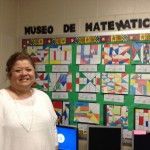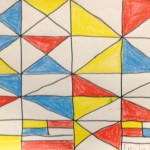I have known my dear friend, Kymberly Riggins since we taught Algebra 1 together at Chavez High School back in 2005. I have always admired her willingness to be innovative in her classroom and keep up with the latest trends in technology. A few months ago, she decided to flip her classroom at the High School for Law Enforcement and Criminal Justice. What does it mean to flip your classroom?
According to Ramsey Musallam who wrote an excellent article titled “Should You Flip Your Classroom?” on edutopia.org, flipped instruction “refers to moving aspects of teaching out of the classroom and into the homework space. With the advent of new technologies, specifically the ability to record digitally annotated and narrated screencasts, instructional videos have become a common medium in the flipped classroom. Although not limited to videos, a flipped classroom most often harnesses different forms of instructional video published online for students.” He also writes that advocates of the flipped classroom “point to its potential as a time-shifting tool,” and that flipping your classroom is a tool to allow you to differentiate instruction and spend more time focused on collaborative activities and higher-order thinking. Musallam adds that critics of the flipped classroom argue that online instruction puts students that lack Internet access at a disadvantage. Also, “whether delivered in class or via instructional videos, lecture is still a poor mode of information transfer.”
I have been a student in online courses in the past, but never taught or was a student in a flipped classroom. So out of curiosity, I visited one of Kym’s geometry classes and videotaped parts of the class.
When students enter her classroom, the first thing that they do is look at a projected spreadsheet with names and assigned tables. They are placed in different groups depending on how they performed on the online quiz that was assigned for homework. Those who did well on the short assessment (missed 0-1) are in the “green” group, those who missed 2-3 are in the “blue” group, students who missed 4-6 are in the “yellow” group, and those either did not take the quiz or got at most 2 correct are in the “red” group. The assignments are different for each group.
Students find homework assignments on Kym’s class website. A typical assignment consists of watching a video (no longer than 15 minutes), taking notes in their interactive notebook (another blog topic), and then completing the online quiz (usually 8 items). A list of assignments for both her geometry and precalculus classes is available here.
After students are seated, Kym goes over the online assessment and answers students’ questions. Then they work in groups on their differentiated tasks. A template of the daily agenda and a sample agenda are available here. Watch a clip of students explaining the format of the class.
During a 90 minute class, about 20 minutes is spent at the beginning of class going over the quiz, and the rest of the time is spent on problem-solving in groups. Kym is available for questions, but students also get help from one another. Watch a clip of a student getting help from Kym. Watch a short clip of students working in groups.
When I asked one of the students what she thought about the flipped classroom vs. a traditional classroom, she shared that “with watching the video at home, you get to pause, rewind, and learn at your own pace.” Listen to her entire response here.
I asked Kym a couple questions about flipping her classroom. One of the interesting things I learned is that she had given her students a survey when she first flipped her classroom and asked how often do they watch the assigned videos. About 30-40% replied very rarely. When she asked why, students responded that “I forgot,” or “I just didn’t.” Their reason not to watch the videos was never lack of access to the internet. After these survey results, she started adding more incentives to motivate students to watch the videos. The rest of the Q&A is available here.
There has been a lot of hype about the flipped classroom, but as Mussalam writes in his article and as Kym demonstrates, “the flipped classroom is a simple concept that needs no title. Good teaching, regardless of discipline, should always limit passive transfer of knowledge in class, and promote learning environments built on the tenants of inquiry, collaboration and critical thinking…good teaching comes in many forms, and the flipped classroom mentality can be one of many solutions for educators.”
If you are interested in flipping your classroom, Musallam outlines the following steps:
Step 1: Identify your current or desired teaching style.
Step 2: Ask yourself this question: Given my style, do I currently use class time to teach any low level, procedural, algorithmic concepts?
Step 3: If yes, begin by creating opportunities for students to obtain this information outside of the classroom. (More info on creating annotated and narrated instructional videos).
Step 4: Include a system that encourages reflection and synthesis of homework-based instruction (Click here and here for ways to make instructional videos more interactive and reflective).
As teachers experiment with different techniques and technologies, we can recall what author and educator Parker Palmer once wrote:
“Good teaching cannot be reduced to one technique; good teaching comes from the identity and integrity of the teacher.”
Let us know what you think about the flipped classroom. Are you ready to flip?





